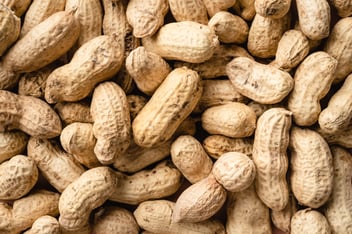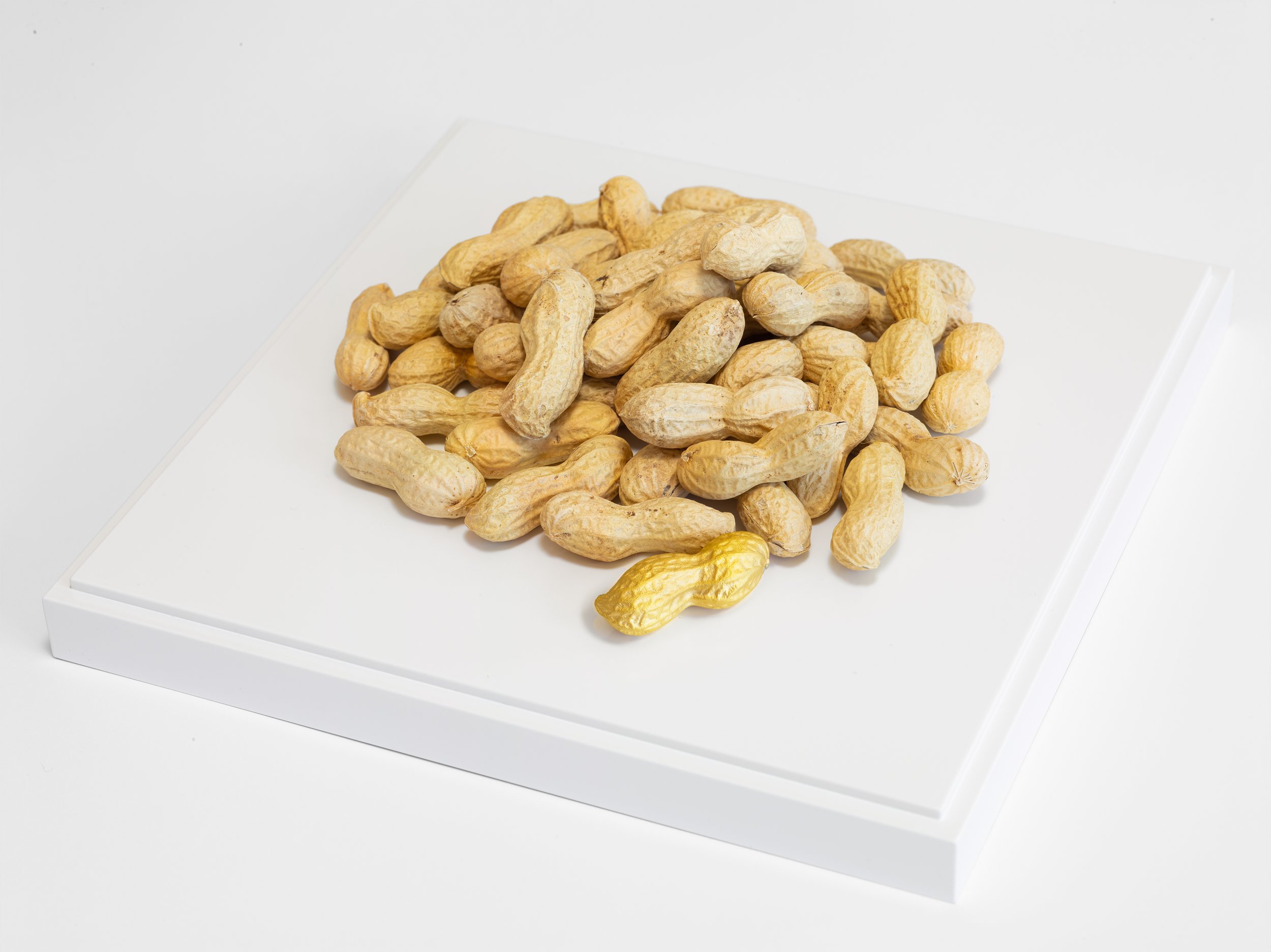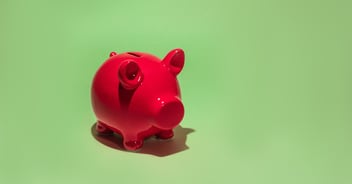
Zurich-born artist Nino Miloni reveals the extraordinary depth hidden inside ordinary objects.
At first it seems straightforward: a pile of peanuts, bought from a budget supermarket for 20 cents and weighing exactly 125 grams, sits alongside a 24-carat gold cast from a single peanut also weighing 125 grams.
No, it isn’t some kind of edible maths problem, but an artwork by lawyer-turned-conceptual artist Nino Miloni; an edition of which was recently acquired by Cape Capital. In Miloni’s words; ‘Peanuts has many layers and meanings; that’s what makes it interesting.’ he says.

"I am not judging which one is better – the gold one or the real peanuts – that’s up to the observer. That’s why I deliberately made them the same weight."
The piece was inspired by his childhood growing up in Switzerland and, specifically, the sixth of December tradition of ‘Samichlaus’; handing out jute bags filled with sweets. ‘I remember eating all the chocolates, gingerbread and cookies, until I was left with the peanuts, which were a filler. That was my starting point: to appreciate the little things in life like peanuts which seemingly have no or little value – which I overlooked when I was young.’
Fast forward to today and, having bought his stash of peanuts, Miloni photographed 10 of them to post on Instagram where he asked friends and followers to vote for their favourite (‘like a beauty contest,’ he quips). The most popular was then sent to Altmann Casting, a family-run specialist in precious metal casting, where a 3D print of the real peanut was made in wax, followed by a gold cast. ‘I bought the cheapest peanuts I could find from a nearby branch of Lidl, and whilst I could have made the golden peanut hollow, I chose to use solid 24-carat gold,’ he explains. ‘Conceptually, it was crucial for me to go to these extremes’.
While a viewer’s initial instinct might be to hone in on the precious metal peanut, is that really the right choice?
One interpretation relates the artwork to the value systems of individuals, and society more broadly; how wealth can be determined by factors other than money. '‘If you were on a remote island, stranded and starving with nothing to eat but peanuts, would you still go for the gold? Is it of any help? Which you choose is all relative to your situation,’ says Miloni.
Another of the many ways of looking at it came from his mother, who forwarded a passage from a book she was reading, ‘Kintsugi: Finding Strength in Imperfection,’ by Céline Santini. ‘The text suggested that humans should be like hardworking squirrels, collecting their own little supply of happiness. If every day you collect your happy moments (like a squirrel hoarding peanuts), whenever you find yourself feeling down, you can immerse yourself in their positivity. Those precious moments are the gold in your life.’
Cape Capital founder Alex Vukajlovic also had an instant reaction when he first saw Peanuts. ‘I knew that’s exactly what should be by our front door,’ he recalls. ‘As a company, from the outside, we might look the same as everybody else but we are definitely not the same. It goes for our team, our investments, our firm – our job is also to find that gold peanut. It’s a brilliant representation of how we see things and how we want to be seen.’
Although Miloni won’t draw on what the piece personally means to him, he will say that it is partly symbolic of the extremes in his own life. ‘On the one hand, there’s the gold peanut. I like nice things: travelling the world, staying in fancy hotels and drinking really good wine. Yet, not least because of Covid-19 and the lockdowns, I have started to re-appreciate small everyday moments; having a deep conversation with close friends, walking my dog, enjoying the scent of rain in the air. It was a reminder that there is value in so much more than materialistic pleasures.'
His first neon art exhibition was four years ago. Since then, all of his works have been based around everyday objects. ‘Neon isn’t such an obvious genre in art collections, but it’s bright, fun and catches people’s attention,’ he says, citing some of his earlier pieces such as Hold and Let Go, an oversized wooden clothes peg, and Traps, which centres around a human sized mouse trap, parts of it being rebuilt in bright, shining red neon. ‘For this, I was inviting people to think about what the traps are in their lives, whether money or something else. I used red neon to play around with the idea of death, underlining the danger and bloody aspect of a mousetrap.’ Since then, Miloni has branched out, experimenting with other mediums and more recently, working on quieter works – of which Peanuts is certainly one. ‘I’m moving towards smaller sculptures, maybe to make the point that something doesn’t always have to be big to be beautiful,’ he says.
Another equally quiet piece is Fortune Cookie (a version of which has previously been exhibited at Cape Capital). ‘I ordered many fortune cookies and again chose the most appealing one. We scanned it in, printed it out with a 3D printer and painted it Baker-Miller Pink, a shade that was invented by Dr. Alexander Schauss, an American psychologist in the 1970s. This very special pink is said to have a calming effect and is generally very dear to me’ he says. Fortune Cookie also has a small, but very bright screen, a motion detector and a microprocessor, so that whenever someone approaches the piece, a fortune cookie quote is randomly generated. ‘When I was talking with employees at Cape Capital about it, one said how every morning when she arrived at the office, the first thing she did was walk up to the Fortune Cookie. She told me that somehow the quote predicted her day. It’s interactive and fun: like a horoscope, you don’t really believe the quote but part of you does.’
Next up is a series based around SPAM, the canned meat. ‘Philippe David, the gallerist with whom I had my first solo exhibition came for dinner and gave me a can as a present. From the very first moment, it looked really attractive; a little Pop Art. But it was only later, after I had done some research, that I discovered that our common understanding of spam (as in a junk email, or sometimes unwanted content on social media feeds like Instagram), derives from this food product which dates back to the 1930s’, says Miloni. ‘It was given to soldiers to eat in WWII but later, after a famous Monty Python sketch, it became symbolic for something that you don’t want in your life. For me, SPAM also stands for the complete sensory overload that many of us experience today.'
New works will include a large scale LED of the SPAM logo in Baker-Miller Pink as well as small, pink concrete sculptures in the same size as the original tin of SPAM.
Ultimately, like the rest of his work, these new creations will hopefully make people think. ‘I am happy if my art is an impetus for collectors and other observers to contemplate life and its purpose, and to reflect on their own challenges,’ he concludes. ‘Peanuts, for instance, is literally just peanuts and gold – simpler than other works of mine but at the same time, so much more.’
Peanuts (2021) is an edition of 3, plus 1 artist proof. It is composed of 125 grams of real peanuts from a local discount store and 125 grams of pure gold (99.9%), dimension variable.
Find out more about Nino Miloni and his artworks here.
44-year-old Miloni’s works draw on his observations and musings about the world around us. Miloni uses a wide range of high-quality materials creating arresting and searching works. In all his pieces Miloni involves, challenges and interrogates the observer, encouraging his audience to question and reflect on their own opinions and perceptions.

As Europe faces macroeconomic shocks, and geopolitical crises, how can two seemingly disparate...

With a brighter future in mind, one of the world’s leading experts in cybersecurity shares his...

Cape Capital’s Head of Fixed Income searches for opportunity in an altogether painful market...